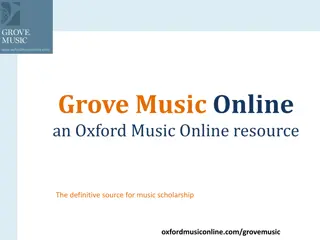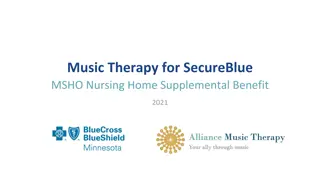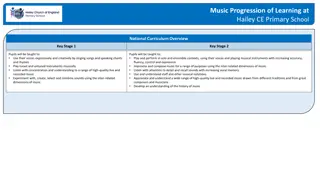Early Years Outcomes and National Curriculum in Music
This content explores the early years outcomes that act as prerequisite skills for music within the national curriculum, covering areas like singing familiar songs, responding to music through movement, exploring sounds, and using various materials. It also outlines the key requirements for music education at Key Stages 1 and 2, emphasizing expressive use of voices, playing instruments, listening to music, composing, and understanding musical notation and history.
Download Presentation

Please find below an Image/Link to download the presentation.
The content on the website is provided AS IS for your information and personal use only. It may not be sold, licensed, or shared on other websites without obtaining consent from the author.If you encounter any issues during the download, it is possible that the publisher has removed the file from their server.
You are allowed to download the files provided on this website for personal or commercial use, subject to the condition that they are used lawfully. All files are the property of their respective owners.
The content on the website is provided AS IS for your information and personal use only. It may not be sold, licensed, or shared on other websites without obtaining consent from the author.
E N D
Presentation Transcript
Learning in EYFS: The following document demonstrates which early years outcomes are prerequisite skills for music within the national curriculum. The table below outlines the most relevant early years outcomes from 30-50 months to ELG, brought together from different areas of the Early Years Foundation Stage, to match the programme of study for music. The most relevant early years outcomes for music are taken from the following areas of learning: Understanding the World Expressive Arts and Design (c) Focus Education (UK) Ltd 1
Music 30-50 Months Expressive Arts and Design Exploring and Using Media and Materials To sing a few familiar songs. To imitate movement in response to music. To tap out simple repeated rhythms. To explore and learn how sounds can be changed. Being Imaginative To develop a preference for forms of expression. To notice what adults do, imitating what is observed and then doing it spontaneously when the adult is not there. To sing to self and make up simple songs. To make up rhythms. To capture experiences and responses with a range of media, such as music, dance and paint and other materials or words. To begin to build a repertoire of songs and dances. 40-60 Months Expressive Arts and Design Exploring and Using Media and Materials To explore the different sounds of instruments. Being Imaginative To create simple representations of events, people and objects. ELG Understandi ng the World Technology To recognise that a range of technology is used in places such as homes and schools. They select and use technology for particular purposes. Expressive Arts and Design Exploring and Using Media and Materials To safely use and explore a variety of materials, tools and techniques, experimenting with colour, design, texture, form and function. Being Imaginative To use what they have learnt about media and materials in original ways, thinking about uses and purposes. They represent their own ideas, thoughts and feelings through design and technology, art, music, dance, role play and stories. (c) Focus Education (UK) Ltd 2
What the national curriculum requires in music at key stage 1 and key stage 2 Pupils should be taught to: Use their voices expressively and creatively by singing songs and speaking chants and rhymes Play tuned and untuned instruments musically Listen with concentration and understanding to a range of high-quality live and recorded music Experiment with, create, select and combine sounds using the inter-related dimensions of music. Key Stage 1 Pupils should be taught to sing and play musically with increasing confidence and control. They should develop an understanding of musical composition, organising and manipulating ideas within musical structures and reproducing sounds from aural memory. Pupils should be taught to: Play and perform in solo and ensemble contexts, using their voices and playing musical instruments with increasing accuracy, fluency, control and expression Improvise and compose music for a range of purposes using the inter-related dimensions of music Listen with attention to detail and recall sounds with increasing aural memory Use and understand staff and other musical notations Appreciate and understand a wide range of high-quality live and recorded music drawn from different traditions and from great composers and musicians Develop an understanding of the history of music. Key Stage 2 (c) Focus Education (UK) Ltd 3
Knowledge, Skills and Understanding breakdown for Music Year 1 Performing Composing (incl notation) Appraising Can they use their voice to speak/sing/chant? Do they join in with singing? Can they use instruments to perform? Do they look at their audience when they are performing? Can they clap short rhythmic patterns? Can they copy sounds? Can they make different sounds with their voice? Can they make different sounds with instruments? Can they identify changes in sounds? Can they change the sound? Can they repeat (short rhythmic and melodic) patterns? Can they make a sequence of sounds? Can they show sounds by using pictures? Can they respond to different moods in music? Can they say how a piece of music makes them feel? Can they say whether they like or dislike a piece of music? Can they choose sounds to represent different things? Can they recognise repeated patterns? Can they follow instructions about when to play or sing? Year 1 (Challenging) Can they make loud and quiet sounds? Do they know that the chorus keeps being repeated? Can they tell the difference between long and short sounds? Can they tell the difference between high and low sounds? Can they give a reason for choosing an instrument? Can they tell the difference between a fast and slow tempo? Can they tell the difference between loud and quiet sounds? Can they identify two types of sound happening at the same time? (c) Focus Education (UK) Ltd 4
Knowledge, Skills and Understanding breakdown for Music Year 2 Performing Composing (incl notation) Appraising Do they sing and follow the melody (tune)? Do they sing accurately at a given pitch? Can they perform simple patterns and accompaniments keeping a steady pulse? Can they perform with others? Can they play simple rhythmic patterns on an instrument? Can they sing/clap a pulse increasing or decreasing in tempo? Can they order sounds to create a beginning, middle and end? Can they create music in response to (different starting points)? Can they choose sounds which create an effect? Can they use symbols to represent sounds? Can they make connections between notations and musical sounds? Year 2 (Challenging) Can they improve their own work? Can they listen out for particular things when listening to music? Can they sing/play rhythmic patterns in contrasting tempo; keeping to the pulse? Can they use simple structures in a piece of music? Do they know that end of phrases are where we breathe in a song? Do they recognise sounds that move by steps and by leaps? (c) Focus Education (UK) Ltd 5
Knowledge, Skills and Understanding breakdown for Music Year 3 Performing Composing (incl notation) Appraising Do they sing in tune with expression? Do they control their voice when singing? Can they play clear notes on instruments? Can they use different elements in their composition? Can they create repeated patterns with different instruments? Can they compose melodies and songs? Can they create accompaniments for tunes? Can they combine different sounds to create a specific mood or feeling? Year 3 (Challenging) Can they improve their work; explaining how it has improved? Can they use musical words (the elements of music) to describe a piece of music and compositions? Can they use musical words to describe what they like and dislike? Can they recognise the work of at least one famous composer? Can they work with a partner to create a piece of music using more than one instrument? Do they understand metre in 2 and 3 beats; then 4 and 5 beats? Do they understand how the use of tempo can provide contrast within a piece of music? Can they tell whether a change is gradual or sudden? Can they identify repetition, contrasts and variations? (c) Focus Education (UK) Ltd 6
Knowledge, Skills and Understanding breakdown for Music Year 4 Performing Composing (incl notation) Appraising Can they perform a simple part rhythmically? Can they sing songs from memory with accurate pitch? Can they improvise using repeated patterns? Can they use notations to record and interpret sequences of pitches? Can they use standard notation? Can they use notations to record compositions in a small group or on their own? Can they use their notation in a performance? Can they explain the place of silence and say what effect it has? Can they start to identify the character of a piece of music? Can they describe and identify the different purposes of music? Can they begin to identify with the style of work of Beethoven, Mozart and Elgar? Year 4 (Challenging) Can they use selected pitches simultaneously to produce simple harmony? Can they explore and use sets of pitches, e.g. 4 or 5 note scales? Can they show how they can use dynamics to provide contrast? Can they identify how a change in timbre can change the effect of a piece of music? (c) Focus Education (UK) Ltd 7
Knowledge, Skills and Understanding breakdown for Music Year 5 Performing Composing (incl notation) Appraising Can they change sounds or organise them differently to change the effect? Can they compose music which meets specific criteria? Can they use their notations to record groups of pitches (chords)? Can they use a music diary to record aspects of the composition process? Can they choose the most appropriate tempo for a piece of music? Do they breathe in the correct place when singing? Can they sing and use their understanding of meaning to add expression? Can they maintain their part whilst others are performing their part? Can they perform by ear and from simple notations? Can they improvise within a group using melodic and rhythmic phrases? Can they recognise and use basic structural forms, e.g. rounds, variations, rondo form? Can they describe, compare and evaluate music using musical vocabulary? Can they explain why they think their music is successful or unsuccessful? Can they suggest improvements to their own or others work? Can they choose the most appropriate tempo for a piece of music? Can they contrast the work of famous composers and show preferences? Year 5 (Challenging) Can they use pitches simultaneously to produce harmony by building up simple chords? Can they devise and play a repeated sequence of pitches on a tuned instrument to accompany a song? Do they understand the relation between pulse and syncopated patterns? Can they identify (and use) how patterns of repetitions, contrasts and variations can be organised to give structure to a melody, rhythm, dynamic and timbre? Can they explain how tempo changes the character of music? Can they identify where a gradual change in dynamics has helped to shape a phrase of music? (c) Focus Education (UK) Ltd 8
Knowledge, Skills and Understanding breakdown for Music Year 6 Performing Composing (incl notation) Appraising Can they sing a harmony part confidently and accurately? Can they perform parts from memory? Can they perform using notations? Can they take the lead in a performance? Can they take on a solo part? Can they provide rhythmic support? Can they use a variety of different musical devices in their composition? (incl melody, rhythms and chords) Do they recognise that different forms of notation serve different purposes? Can they use different forms of notation? Can they combine groups of beats? Can they refine and improve their work? Can they evaluate how the venue, occasion and purpose affects the way a piece of music is created? Can they analyse features within different pieces of music? Can they compare and contrast the impact that different composers from different times will have had on the people of the time? Year 6 (Challenging) Can they perform a piece of music which contains two (or more) distinct melodic or rhythmic parts, knowing how the parts will fit together? Can they show how a small change of tempo can make a piece of music more effective? Do they use the full range of chromatic pitches to build up chords, melodic lines and bass lines? Can they appraise the introductions, interludes and endings for songs and compositions they have created? (c) Focus Education (UK) Ltd 9























